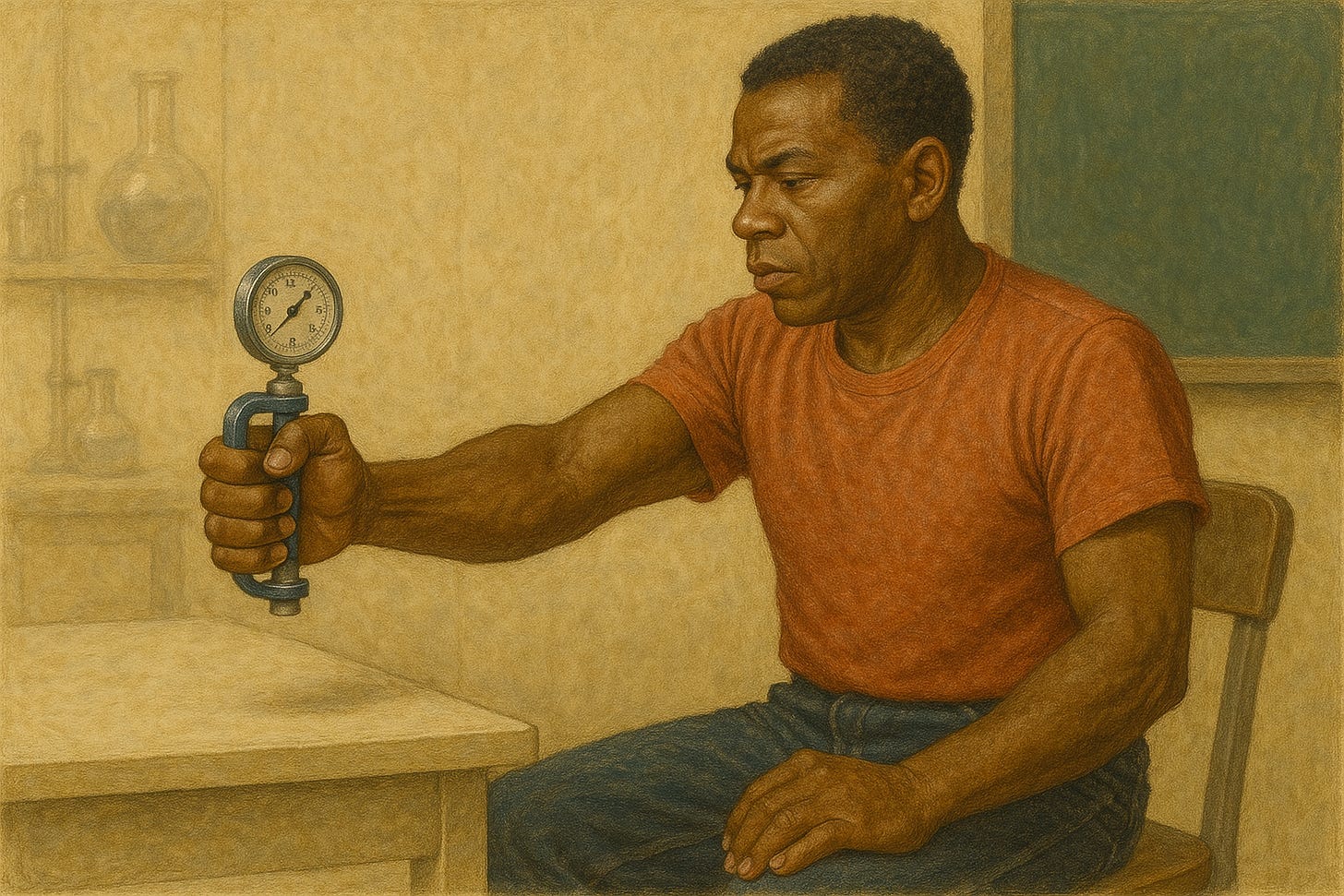THE GRIP TEST
Longevity Predictor & Nervous System Readiness Tool
Grip strength is widely recognized as a strong predictor of longevity and overall health, but it also serves as a useful tool for assessing nervous system readiness, fatigue, and recovery in athletes. Below, I’ll break down the key aspects of grip strength related to longevity and nervous system readiness, including landmark studies that have shaped our understanding.
Grip Strength as a Longevity Predictor
Several large-scale studies have established grip strength as a reliable biomarker for predicting longevity, disease risk, and overall functional health. Some of the most notable findings include:
1. PURE Study (2018) – Lancet
Study: The Prospective Urban and Rural Epidemiological (PURE) Study analyzed data from 139,691 adults across 17 countries.
Findings:
Grip strength was a stronger predictor of all-cause mortality than systolic blood pressure.
Each 5 kg decline in grip strength was associated with a 16% higher risk of death, 17% increased risk of cardiovascular disease, and 7% increased risk of myocardial infarction.
Grip strength predicted outcomes independent of other risk factors such as age, sex, and lifestyle factors.
Conclusion: Declining grip strength is strongly correlated with increased mortality and cardiovascular disease risk, making it a powerful, simple, and cost-effective marker of overall health.
Reference: Leong, D. P., et al. (2018). Prognostic value of grip strength: findings from the Prospective Urban Rural Epidemiology (PURE) study. The Lancet, 386(9990), 266-273.
2. UK Biobank Study (2015) – BMJ
Study: Analyzed 500,000 participants aged 40-69.
Findings:
Stronger grip strength correlated with lower risk of cardiovascular mortality, respiratory disease, and cancer-related deaths.
Grip strength was a better predictor of functional decline and frailty than chronological age.
Conclusion: Handgrip strength serves as a reliable indicator of biological age and muscle quality, making it a valuable tool for aging and health assessment.
Reference: Gale, C. R., et al. (2015). Grip strength, body composition, and mortality. BMJ, 350, h881.
Grip Strength and Nervous System Readiness
Beyond longevity, grip strength is increasingly used in sports science and high-performance training as a real-time indicator of nervous system readiness. This application relies on the autonomic nervous system’s role in force production and fatigue management.
How Grip Strength Reflects Nervous System Fatigue
Grip strength is primarily neurologically driven, meaning it reflects central nervous system (CNS) fatigue rather than just muscular fatigue.
Reduced grip strength, especially when compared to an athlete’s baseline, indicates poor neuromuscular readiness, overtraining, or lack of recovery.
Grip strength is highly correlated with cortisol levels and HRV (Heart Rate Variability), two key markers of nervous system stress.
3. Haff et al. (2015) – Sports Science Study
Study: Examined grip strength variations in weightlifters and strength athletes to monitor CNS fatigue.
Findings:
Athletes showed significantly lower grip strength scores after high-intensity training or inadequate recovery.
Grip strength was correlated with reaction time, explosiveness, and overall fatigue.
Monitoring grip strength over consecutive training sessions helped identify when athletes needed additional recovery.
Conclusion: Grip strength testing provides a non-invasive, quick, and effective way to assess athletic readiness and overtraining risks.
Reference: Haff, G. G., et al. (2015). Assessing neuromuscular fatigue using grip strength in resistance-trained athletes. Journal of Strength and Conditioning Research, 29(3), 611-618.
4. Sayers et al. (2020) – Grip Strength and HRV
Study: Investigated the relationship between grip strength and autonomic nervous system recovery in endurance athletes.
Findings:
Grip strength decreased significantly following endurance races and remained low for 48-72 hours post-event.
Athletes with higher grip strength recovery within 24 hours also had faster heart rate variability (HRV) recovery, indicating a well-functioning autonomic nervous system.
Conclusion: Grip strength serves as a real-time fatigue indicator and can be used alongside HRV to assess readiness for high-intensity training.
Reference: Sayers, S. P., et al. (2020). Grip strength as a measure of autonomic nervous system readiness in endurance athletes. European Journal of Applied Physiology, 120(5), 1141-1151.
Practical Applications for Athletes and Coaches
1. Baseline Testing
Athletes should measure daily or weekly grip strength under similar conditions (same time of day, dominant hand, consistent device).
Any significant drop (~5% or more from baseline) suggests CNS fatigue, poor recovery, or overtraining.
2. Monitoring Recovery
Reduced grip strength after intense workouts may indicate delayed recovery.
Tracking grip strength over time can help optimize training load and avoid burnout.
3. Readiness for Training
If grip strength remains low for multiple days, it may be wise to adjust training intensity (e.g., shift to low-intensity aerobic work or mobility drills instead of heavy lifting).
If grip strength is higher than baseline, an athlete may be primed for high-performance sessions.
Performing a Grip Assessment
If you don't have a hand grip dynamometer, you can use a simple alternative method to measure this:
Step 1: Use your bathroom scale. On a day when you have slept for 8 hours and not consumed alcohol, squeeze the scale as hard as you can for 15 seconds.
Step 2: Note the pinch grip 'weight' (in pounds) that you were able to hold for 15 seconds.
Step 3: On the training day morning(s) in question, pinch the scale for 15 seconds. If the force generated is 20% less than your benchmark, you might not be ready for a strenuous training session, and it's advisable to have an easier training day instead
Final Thoughts
Grip strength is a powerful, low-cost, and non-invasive biomarker with significant applications in both longevity prediction and nervous system readiness. Research has consistently shown that weaker grip strength correlates with higher mortality, while short-term fluctuations reflect CNS fatigue and training adaptation.
Using grip strength as a daily or weekly check-in can provide valuable insights into overall health, recovery, and training readiness, making it an essential tool for both general health monitoring and elite athletic performance.




I love the bathroom scale alternative to a grip dynamometer. We don’t have a bathroom scale like that. So I guess I’ll have to buy one unless there’s a better suggestion. Thanks for the great information!